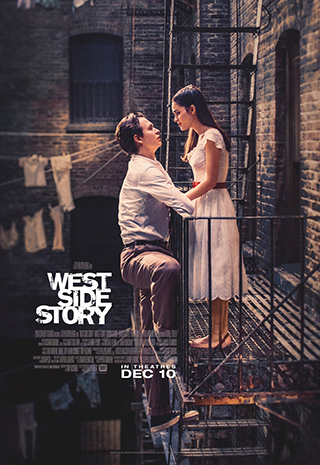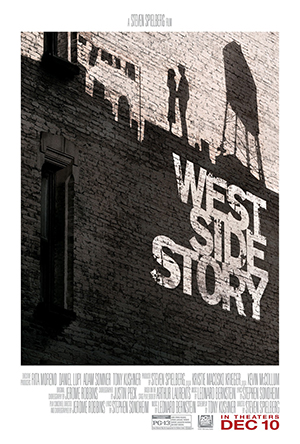Movies

New Releases • A-D • E-H • I-P • Q-Z • Articles • Festivals • Interviews • Dark Knight • Indiana Jones • MCU
Tonight! Go behind the scenes of West Side Story with director Steven Spielberg
Film clip and featurette: 20th Century Studios
West Side Story (2021)
Directed by Steven Spielberg
Rated PG-13
Romanced 10 December 2021
#WestSideStory
Steven Spielberg’s West Side Story is the kind of exhilarating theatrical experience the best of filmmaking is all about.
Anything Goes

It’s unfair — actually, it’s incorrect — to refer to this production as a remake of the 1961 Oscar-winning film. Spielberg’s gone further back, returning to Arthur Laurents’ original stage book for the 1957 Tony-winning Broadway production. But he’s also brought back Rita Moreno (who won an Oscar for her performance as Anita) for a wholly reimagined character that fits in seamlessly.
Doing so has opened a whole new world for this musical (Spielberg’s personal favorite), revitalizing the music and the staging and bringing the story (which is commonly referenced as a retelling of Shakespeare’s Romeo & Juliet) up to contemporary standards while keeping the setting in 1950s New York City.
The result is a stunning example of an A-list director thoroughly operating in his element, even though this is his first feature musical. One cannot forget, however, Spielberg opened Indiana Jones and the Temple of Doom with a rousing staging of Cole Porter’s Anything Goes (sung by Kate Capshaw, now Spielberg’s wife, in Chinese) and there were those big band dance scenes in 1941. Even back then, Spielberg talked about wanting to make a musical and how, ultimately, he wanted to have a career like Michael Curtiz.
Ah. Curtiz. The director most people don’t know by name, but almost everybody knows his movies. They include Casablanca (Humphrey Bogart and Ingrid Bergman), White Christmas (Bing Crosby and Danny Kaye) and King Creole (Elvis Presley).
Spielberg’s always been fluent in the languages of cinema and visual storytelling, going back to the early days and Night Gallery; it’s hard to think of a movie format that affords more opportunities to tap that talent than the musical.
Get Ready to Rumble
Right from the start, Spielberg puts the situation in a refreshed context. Signs announce the clearing out of slums in Manhattan’s Upper West Side. Concept art shows what’s to come in their place: the Lincoln Center for the Performing Arts.
With gentrification imposing on the Jets’ turf, the gang’s at a breaking point, already having to contend with the influx of Puerto Ricans. Sure, they’re citizens, but they’re not “us.” Up to their typical no-good hoodlum shenanigans, a run-in with the law becomes an appeal for the kids to do something with their lives. Most people climb their way out of the slums, they’re advised. But the Jets represent the last of the “can’t make it” Caucasians. The dialogue’s become crisper, with more bite.
In this production, more effort is put into fleshing out Tony’s character; he spent a year in the slammer for beating up — and nearly killing — a member of a rival gang. It’s an encounter that’s haunted him ever since and he’s committed to living a clean life. This back story makes Tony more sympathetic and offers a reason for hope amidst the madness, a light to come out of the darkness.
But, as fate would have it, Tony agrees to go to a dance that changes everything.
Enter Maria and a world of love and conflict. And Maria gives Tony a reason to find higher ground, to be one of the Caucasians that escapes the decay of the slums.
The staging of their meeting is slick. The music sounds fantastic, the choreography fresh.
In Spielberg’s hands, classic songs like Maria, Tonight, America and I Feel Pretty take on a higher level of energy and a whole new vitality. These songs (with lyrics by the late, great Stephen Sondheim) truly have never sounded better. Extend that right out to the soundtrack streaming on Apple in a stellar lossless format with Dolby Atmos. It’s aural awesomeness.
Tonight in particular is an example of pure cinematic joy carrying forward from the lighting to the choreography to the vocal performances. It’s a movie, but it has the energy of a live stage production and that is quite a feat. And to their credit, newcomer Rachel Zegler and the more seasoned Ansel Elgort (Baby Driver) make a wholly appealing pair as Maria and Tony.
Film Magic
After Tony meets Maria, the lovestruck couple makes plans to meet again. The setting’s a subway station, a common facet of New York City life. But something’s going on. The color tone, the era-appropriate signage, the costumes — all those things are to be expected. Even so, there’s something oddly comforting, strangely familiar. There’s something else — what is it? It’s a sense of texture, of grain — film grain.
At that moment there’s a renewed sense of a movie being alive. Thank the movie heavens, West Side Story was shot on film!
Of course. Spielberg — and a handful of other directors — still values the pure aesthetics of shooting on film rather than with digital cameras. In this era of Marvel’s digital machinery, the effect is even more pronounced and striking. It’s breathtaking filmmaking: the camera angles, the lighting, the close ups, the wide shots, the camera movements, the fresh faces, the incredible sound of the reinvigorated music.
So many movies today feel like they’re an assembly line product. Black Widow is a prime example of a movie that offers nothing that’s particularly remarkable or inventive. The idea of a director’s film “signature” is becoming a lost art form. Watching West Side Story is to bask in the comforting glow of a brilliant filmmaker working with the mojo in high gear. And it needs to be seen on the big screen. The bigger, the better — and West Side Story is even being given the IMAX treatment. Savor every moment.
Timeless Relevance
The 1961 movie directed by Robert Wise and Jerome Robbins feels dated in many respects, including the casting of Natalie Wood — a rising starlet of Russian and Ukrainian descent — as the Puerto Rican love interest, Maria (Rita Morena played her sister, Anita, in that film). But what’s striking is to revisit it now and consider how forward-thinking it was, while undoubtedly limited by the need to wrangle with the moviegoing sensibilities of audiences at the time.
And therein is another reason to celebrate what Spielberg’s done, starting with the baseline of pursuing a level of authenticity in the casting, starting with pitch-perfect Zegler as Maria. And there’s a peculiar lack of subtitles, regardless of the language spoken.
But there are also so many themes on tap in West Side Story, themes Spielberg, with a screenplay by frequent collaborator Tony Kushner (Lincoln, Munich), elevates and brings to the center of the stage.
The 1961 movie had all the talk of racial tensions, marijuana, delinquency and gangs, but, decades later, they’re still here — even more pronounced — and it’s time to polish up those topics and cast a modern light on them. It’s rather shocking how relevant the whole storyline is today. The psychological impact of neglected children and detached parents is front and center. As the lyrics go, they’re “not anti-social, just anti-work.” And there’s more, including “sister has a mustache, brother wears a dress.”
Also consider the character identified simply as “Anybodys.” In 1961, she was basically a tomboy. Now, Iris Menas (in her big screen debut) casts new light on the character, placing her more in the context of today’s gender discussions. It’s the same character, serving the same narrative purpose. But the character resonates anew, for modern times.
And, of course, there’s the violence of the gangs. Guns serve one purpose in their world: mutually assured destruction. As the Jets run through the rubble, their gunplay with each other displays no appreciation for the reality of the violence they inflict. The Jets play like they’re in a movie and the Sharks are merely a collection of nameless, faceless punks raiding their resources. It’s all counter-intuitive, if only they’d stop and think. It makes no sense to demonstrate how strong one is by dying under gunfire.
Ultimately, it’s Maria’s words that sum it up in the aftermath of the calamity: “I can kill because I hate now.”
• Originally published at MovieHabit.com.



